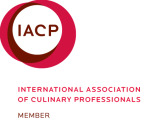Let’s take a quick break from chocolate to talk about layers. More about texture than taste, layers make things delicious.
For instance, Chinese green onion pancakes: this simple mixture of rice flour, water, salt and green onions is wholly unremarkable on its own. But consider that a great green onion pancake is characterized by a thin, crisp crust and lots of beautiful, flaky layers inside.
I think the ultimate example is baklava. Think about it: layers and layers of filo, each separated by a thin coat of butter, the entire mass drizzled with honey and topped with nuts? And then baked until it rises into a pile of flaky, buttery pastry? Sure, it’s messy to eat, but there’s something about the insane flakiness, tempered with sticky honey, that makes baklava one of the most delightful things on earth.
And for you Vancouverites, a variation on a theme: the pistachio baklava at Mediterranean Specialty Foods is amazing. Imagine a few sheets of filo, each one brushed with butter before the next one goes on. In your mind, take this multi-sheet thing of filo and roll it into a very tight cylinder. Cut the cylinder into small sections, and bring the ends together to make a donut out of the filo. Finally, imagine filling the inside of the donut with honey and toasted pistachios, and baking this creature until it’s golden-brown, crisp, and delicious.
The resulting pastry is so insanely flaky and fragrant that it’s almost heartbreaking. The effect of rolling, rather than stacking, the filo creates the sensation of tens of thousands of layers in your mouth, each one exploding with each bite.
At just over a dollar per piece (I think it’s $1.25 each), it’s an amazingly cheap way to get an epicurian high. And if you’re craving savoury, the spanakopita is the best in the city.
Mediterranean Specialty Foods
1824 Commercial Drive
Vancouver, BC
604-438-4033



